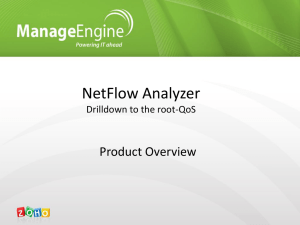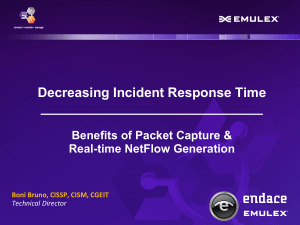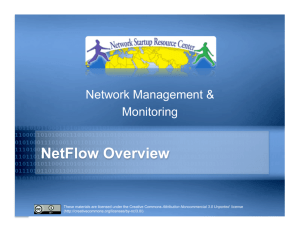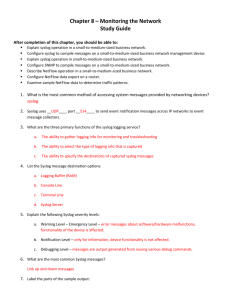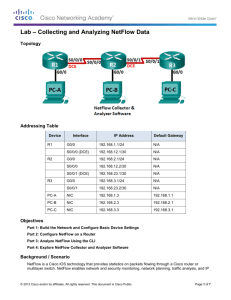Cisco Nexus NetFlow document
advertisement
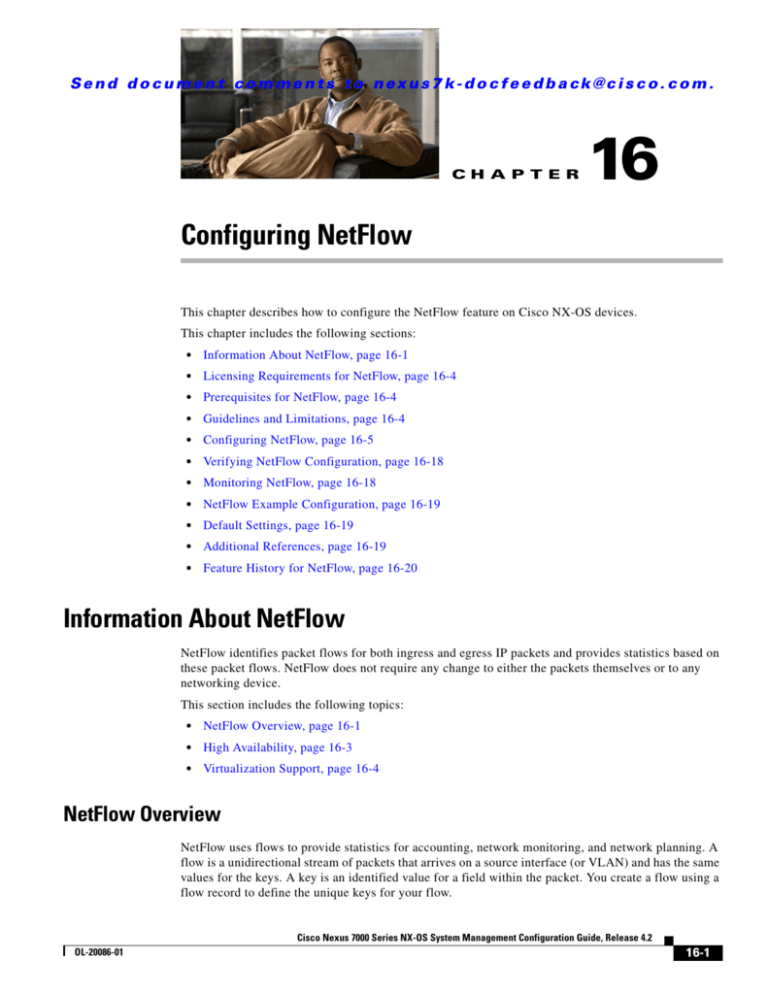
S e n d d o c u m e n t c o m m e n t s t o n ex u s 7 k - d o c f e e d b a ck @ c i s c o . c o m .
CH A P T E R
16
Configuring NetFlow
This chapter describes how to configure the NetFlow feature on Cisco NX-OS devices.
This chapter includes the following sections:
•
Information About NetFlow, page 16-1
•
Licensing Requirements for NetFlow, page 16-4
•
Prerequisites for NetFlow, page 16-4
•
Guidelines and Limitations, page 16-4
•
Configuring NetFlow, page 16-5
•
Verifying NetFlow Configuration, page 16-18
•
Monitoring NetFlow, page 16-18
•
NetFlow Example Configuration, page 16-19
•
Default Settings, page 16-19
•
Additional References, page 16-19
•
Feature History for NetFlow, page 16-20
Information About NetFlow
NetFlow identifies packet flows for both ingress and egress IP packets and provides statistics based on
these packet flows. NetFlow does not require any change to either the packets themselves or to any
networking device.
This section includes the following topics:
•
NetFlow Overview, page 16-1
•
High Availability, page 16-3
•
Virtualization Support, page 16-4
NetFlow Overview
NetFlow uses flows to provide statistics for accounting, network monitoring, and network planning. A
flow is a unidirectional stream of packets that arrives on a source interface (or VLAN) and has the same
values for the keys. A key is an identified value for a field within the packet. You create a flow using a
flow record to define the unique keys for your flow.
Cisco Nexus 7000 Series NX-OS System Management Configuration Guide, Release 4.2
OL-20086-01
16-1
Chapter 16
Configuring NetFlow
Information About NetFlow
Se n d d o c u m e n t c o m m e n t s t o n ex u s 7 k - d o c f e e d b a ck @ c i s c o . c o m .
Cisco NX-OS supports the Flexible NetFlow feature that enables enhanced network anomalies and
security detection. Flexible NetFlow allows you to define an optimal flow record for a particular
application by selecting the keys from a large collection of predefined fields. For more information on
the flow records, see the “Flow Records” section on page 16-2.
All key values must match for the packet to count in a given flow. A flow might gather other fields of
interest, depending on the export record version that you configure. Flows are stored in the NetFlow
cache.
You can export the data that NetFlow gathers for your flow by using an exporter and export this data to
a remote NetFlow collector. Cisco NX-OS exports a flow as part of a NetFlow export User Datagram
Protocol (UDP) datagram under the following circumstances:
•
The flow has been inactive or active for too long.
•
The flow cache is getting full.
•
One of the counters (packets or bytes) has exceeded its maximum value.
•
You have forced the flow to export.
For more information on exporters, see the “Exporters” section on page 16-2.
You define the size of the data that you want to collect for a flow using a monitor. The monitor combines
the flow record and exporter with the NetFlow cache information. For more information on monitors,
see the “Monitors” section on page 16-3.
Cisco NX-OS can gather NetFlow statistics in either full or sampled mode. Cisco NX-OS analyzes all
packets on the interface or subinterface for full NetFlow mode. For sampled mode, you configure the
sampling algorithm and rate that Cisco NX-OS analyzes packets. For more information on samplers, see
the “Samplers” section on page 16-3.
Flow Records
A flow record defines the keys that NetFlow uses to identify packets in the flow as well as other fields
of interest that NetFlow gathers for the flow. You can define a flow record with any combination of keys
and fields of interest. Cisco NX-OS supports a rich set of keys. A flow record also defines the types of
counters gathered per flow. You can configure 32-bit or 64-bit packet or byte counters. Cisco NX-OS
enables the following match fields as the defaults when you create a flow record:
•
match interface input
•
match interface output
•
match flow direction
For more information, see the “Creating a Flow Record” section on page 16-6.
Exporters
An exporter contains network layer and transport layer details for the NetFlow export packet. You can
configure the following information in an exporter:
•
Export destination IP address
•
Source interface
•
UDP port number (where the collector is listening for NetFlow packets)
•
Export format
Cisco Nexus 7000 Series NX-OS System Management Configuration Guide, Release 4.2
16-2
OL-20086-01
Chapter 16
Configuring NetFlow
Information About NetFlow
S e n d d o c u m e n t c o m m e n t s t o n ex u s 7 k - d o c f e e d b a ck @ c i s c o . c o m .
Note
NetFlow export packets use the IP address that is assigned to the source interface. If the source interface
does not have an IP address assigned to it, the exporter will be inactive.
Cisco NX-OS exports data to the collector whenever a timeout occurs or when the flow is terminated
(TCP Fin or Rst received, for example). You can configure the following timers to force a flow export:
•
Active timeout—Cisco NX-OS does not remove the cache entries from the cache.
•
Inactive timeout—Cisco NX-OS removes the cache entries from the cache.
Export Formats
Cisco NX-OS supports the Version 5 and Version 9 export formats. We recommend that you use the
Version 9 export format for the following reasons:
•
Variable field specification format
•
Support for IPv6, Layer 2, and MPLS fields
•
More efficient network utilization
If you configure the Version 5 export format, you have these limitations:
•
Fixed field specifications
•
A 16-bit representation of the 32-bit interface index used in Cisco NX-OS
•
No support for IPv6, Layer 2, or MPLS fields
For information about the Version 9 export format, see RFC 3954.
Note
Cisco NX-OS supports UDP as the transport protocol for exports to up to two collectors.
Monitors
A monitor references the flow record and flow exporter. You apply a monitor to an interface.
Samplers
If you are using sampled mode, you use the sampler to specify the rate at which packets are sampled. On
high bandwidth interfaces, applying NetFlow processing to every single packet can result in high CPU
utilization. Sampler configuration is for high-speed interfaces. You can configure samples for M out of
N. For example, 100 out of every 10,000 packets are sampled.
High Availability
Cisco NX-OS supports stateful restarts for NetFlow. After a reboot or supervisor switchover, Cisco
NX-OS applies the running configuration.
Cisco Nexus 7000 Series NX-OS System Management Configuration Guide, Release 4.2
OL-20086-01
16-3
Chapter 16
Configuring NetFlow
Licensing Requirements for NetFlow
Se n d d o c u m e n t c o m m e n t s t o n ex u s 7 k - d o c f e e d b a ck @ c i s c o . c o m .
Virtualization Support
A virtual device context (VDC) is a logical representation of a set of system resources. Within each
VDC, you can configure NetFlow. By default, Cisco NX-OS places you in the default VDC and any
flows that you define in this mode are only available for interfaces in the default VDC.
For information about configuring VDCs, see the Cisco Nexus 7000 Series NX-OS Virtual Device
Context Configuration Guide, Release 4.2.
Licensing Requirements for NetFlow
Product
License Requirement
NX-OS
NetFlow requires no license. Any feature not included in a license package is bundled with the Cisco NX-OS
system images and is provided at no extra charge to you. For a complete explanation of the NX-OS licensing
scheme. For more information, see the Cisco Nexus 7000 Series NX-OS Licensing Guide, Release 4.2.
Prerequisites for NetFlow
NetFlow has the following prerequisite:
•
You must understand the resources required on your device because NetFlow consumes additional
memory and CPU resources.
If you configure VDCs, install the Advanced Services license and enter the desired VDC. For more
information, see the Cisco Nexus 7000 Series NX-OS Virtual Device Context Configuration Guide,
Release 4.2.
Guidelines and Limitations
NetFlow has the following configuration guidelines and limitations:
•
You must configure a source interface. If you do not configure a source interface, the exporter will
remain in a disabled state.
•
You must configure a valid record name for every flow monitor.
•
A rollback will fail if you try to modify a record that is programmed in the hardware during a
rollback.
•
Only Layer 2 NetFlow is applied on Layer 2 interfaces, and only Layer 3 NetFlow is applied on
Layer 3 interfaces.
•
If you add a member to a port channel that is already configured for Layer 2 NetFlow, its NetFlow
configuration is removed and the Layer 2 configuration of the port channel is added to it.
•
If you change a Layer 2 interface to a Layer 3 interface, the software removes the Layer 2 NetFlow
configuration from the interface.
•
Use v9 export to see the full 32-bit SNMP ifIndex values at the NetFlow connector.
Cisco Nexus 7000 Series NX-OS System Management Configuration Guide, Release 4.2
16-4
OL-20086-01
Chapter 16
Configuring NetFlow
Configuring NetFlow
S e n d d o c u m e n t c o m m e n t s t o n ex u s 7 k - d o c f e e d b a ck @ c i s c o . c o m .
Configuring NetFlow
To configure NetFlow, follow these steps:
Step 1
Enable the NetFlow feature (see the “Enabling the NetFlow Feature” section on page 16-5).
Step 2
Define a flow record by specifying keys and fields to the flow (see the “Creating a Flow Record” section
on page 16-6).
Step 3
Define an optional flow exporter by specifying the export format, protocol, destination, and other
parameters (see the “Creating a Flow Exporter” section on page 16-9).
Step 4
Define a flow monitor based on the flow record and flow exporter (see the “Creating a Flow Monitor”
section on page 16-11).
Step 5
Apply the flow monitor to a source interface, subinterface, VLAN interface (see the “Applying a Flow
to an Interface” section on page 16-13), or a VLAN (see the “Configuring Bridged NetFlow on a VLAN”
section on page 16-14).
This section includes the following topics:
Note
•
Enabling the NetFlow Feature, page 16-5
•
Creating a Flow Record, page 16-6
•
Creating a Flow Exporter, page 16-9
•
Creating a Flow Monitor, page 16-11
•
Creating a Sampler, page 16-12
•
Applying a Flow to an Interface, page 16-13
•
Configuring Bridged NetFlow on a VLAN, page 16-14
•
Configuring Layer 2 NetFlow, page 16-15
•
Configuring NetFlow Timeouts, page 16-17
Be aware that the Cisco NX-OS commands for this feature may differ from those used in Cisco IOS.
Enabling the NetFlow Feature
You must globally enable NetFlow before you can configure any flows.
Use the following command in global configuration mode to enable NetFlow:
Command
Purpose
feature netflow
Enables the NetFlow feature.
Example:
switch(config)# feature netflow
Cisco Nexus 7000 Series NX-OS System Management Configuration Guide, Release 4.2
OL-20086-01
16-5
Chapter 16
Configuring NetFlow
Configuring NetFlow
Se n d d o c u m e n t c o m m e n t s t o n ex u s 7 k - d o c f e e d b a ck @ c i s c o . c o m .
Use the following command in global configuration mode to disable NetFlow and remove all flows:
Command
Purpose
no feature netflow
Disables the NetFlow feature. The default is
disabled.
Example:
switch(config)# no feature netflow
Creating a Flow Record
You can create a flow record and add keys to match on and fields to collect in the flow.
BEFORE YOU BEGIN
Make sure that you are in the correct VDC. To change the VDC, use the switchto vdc command.
SUMMARY STEPS
1.
config t
2.
flow record name
3.
description string
4.
match type
5.
collect type
6.
show flow record [name] [record-name | netflow-original | netflow protocol-port | netflow {ipv4
| ipv6} {original-input | original-output}}
7.
copy running-config startup-config
DETAILED STEPS
Step 1
Command
Purpose
config t
Places you in global configuration mode.
Example:
switch# config t
Enter configuration commands, one per
line. End with CNTL/Z.
switch(config)#
Step 2
flow record name
Example:
switch(config)# flow record Test
switch(config-flow-record)#
Step 3
description string
Example:
switch(config-flow-record)# description
Ipv4Flow
Creates a flow record and enters flow record
configuration mode.
(Optional) Describes this flow record as a maximum
63-character string.
Cisco Nexus 7000 Series NX-OS System Management Configuration Guide, Release 4.2
16-6
OL-20086-01
Chapter 16
Configuring NetFlow
Configuring NetFlow
S e n d d o c u m e n t c o m m e n t s t o n ex u s 7 k - d o c f e e d b a ck @ c i s c o . c o m .
Step 4
Command
Purpose
match type
Specifies a match key. See the “Specifying the Match
Parameters” section on page 16-7 for more
information on the type argument.
Example:
switch(config-flow-record)# match
transport destination-port
Step 5
collect type
Example:
switch(config-flow-record)# collect
counter packets
Step 6
show flow record [name] [record-name |
netflow-original | netflow protocol-port
| netflow {ipv4 | ipv6} {original-input
| original-output}}
Specifies the collection field. See the “Specifying the
Collect Parameters” section on page 16-8 for more
information on the type argument.
(Optional) Displays information about NetFlow flow
records.
Example:
switch(config-flow-exporter)# show flow
record netflow protocol-port
Step 7
copy running-config startup-config
(Optional) Saves this configuration change.
Example:
switch(config-flow-exporter)# copy
running-config startup-config
Specifying the Match Parameters
You must configure at least one of the following match parameters for flow records:
Command
Purpose
match ip {protocol | tos}
Specifies the IP protocol or ToS fields as keys.
Example:
switch(config-flow-record)# match ip
protocol
match ipv4 {destination address | source
address}
Specifies the IPv4 source or destination address as a
key.
Example:
switch(config-flow-record)# match ipv4
destination address
match ipv6 {destination address | source
address | flow-label | options}
Specifies the IPv6 key.
Example:
switch(config-flow-record)# match ipv6
flow-label
Cisco Nexus 7000 Series NX-OS System Management Configuration Guide, Release 4.2
OL-20086-01
16-7
Chapter 16
Configuring NetFlow
Configuring NetFlow
Se n d d o c u m e n t c o m m e n t s t o n ex u s 7 k - d o c f e e d b a ck @ c i s c o . c o m .
Command
Purpose
match transport {destination-port |
source-port}
Specifies the transport source or destination port as a
key.
Example:
switch(config-flow-record)# match
transport destination-port
match datalink {mac source-address | mac
destination-address | ethertype | vlan}
Specifies the Layer 2 attribute as a key.
Example:
switch(config-flow-record)# match
datalink ethertype
Specifying the Collect Parameters
You must configure at least one of the following collect parameters for flow records:
Command
Purpose
collect counter {bytes | packets} [long]
Collects either packet-based or byte counters from the
flow. You can optionally specify that 64-bit counters
are used.
Example:
switch(config-flow-record)# collect
counter packets
collect flow {direction | sampler id}
Example:
switch(config-flow-record)# collect flow
direction
collect routing {destination | source}
as [peer]
Collects the direction of the flow or the sampler
identifier used for the flow.
Collects the source or destination AS number of the
local device or the peer.
Example:
switch(config-flow-record)# collect
routing destination as
collect routing forwarding-status
Collects the forwarding status of the packet.
Example:
switch(config-flow-record)# collect
routing forwarding-status
collect routing next-hop address ipv4
[bgp]
Collects the next-hop IPv4 address.
Example:
switch(config-flow-record)# collect
routing next-hop address ipv4
Cisco Nexus 7000 Series NX-OS System Management Configuration Guide, Release 4.2
16-8
OL-20086-01
Chapter 16
Configuring NetFlow
Configuring NetFlow
S e n d d o c u m e n t c o m m e n t s t o n ex u s 7 k - d o c f e e d b a ck @ c i s c o . c o m .
Command
Purpose
collect routing next-hop address ipv6
[bgp]
Collects the next-hop IPv6 address.
Example:
switch(config-flow-record)# collect
routing next-hop address ipv6
collect timestamp sys-uptime {first |
last}
Collects the system up time for the first or last packet
in the flow.
Example:
switch(config-flow-record)# collect
timestamp sys-uptime last
collect transport tcp flags
Example:
switch(config-flow-record)# collect
transport tcp flags
Collects the TCP transport layer flags for the packets
in the flow.
Creating a Flow Exporter
You can create a flow export to define the export parameters for a flow.
BEFORE YOU BEGIN
Make sure that you are in the correct VDC. To change the VDC, use the switchto vdc command.
SUMMARY STEPS
1.
config t
2.
flow exporter name
3.
destination {ipv4-address | ipv6-address} [use-vrf name]
4.
source interface-type number
5.
version {5 | 9}
6.
show flow exporter [name]
7.
copy running-config startup-config
Cisco Nexus 7000 Series NX-OS System Management Configuration Guide, Release 4.2
OL-20086-01
16-9
Chapter 16
Configuring NetFlow
Configuring NetFlow
Se n d d o c u m e n t c o m m e n t s t o n ex u s 7 k - d o c f e e d b a ck @ c i s c o . c o m .
DETAILED STEPS
Step 1
Command
Purpose
config t
Places you in global configuration mode.
Example:
switch# config t
Enter configuration commands, one per
line. End with CNTL/Z.
switch(config)#
Step 2
flow exporter name
Example:
switch(config)# flow exporter ExportTest
switch(config-flow-exporter)#
Step 3
destination {ipv4-address |
ipv6-address} [use-vrf name]
Example:
switch(config-flow-exporter)#
destination 192.0.2.1
Step 4
source interface-type number
Example:
switch(config-flow-exporter)# source
ethernet 2/1
Step 5
version {5 | 9}
Example:
switch(config-flow-exporter)# version 9
switch(config-flow-exporter-version-9)#
Step 6
show flow exporter [name]
Example:
switch(config-flow-exporter)# show flow
exporter
Step 7
copy running-config startup-config
Creates a flow exporter and enters flow exporter
configuration mode.
Sets the destination IPv4 or IPv6 address for this
exporter. You can optionally configure the VRF to use
to reach the NetFlow collector.
Specifies the interface to use to reach the NetFlow
collector at the configured destination.
Specifies the NetFlow export version. Version 9 enters
the export version configuration submode.
(Optional) Displays information about NetFlow flow
exporters.
(Optional) Saves this configuration change.
Example:
switch(config-flow-exporter)# copy
running-config startup-config
You can optionally configure the following parameters for flow exporters:
Command
Purpose
description string
Describes this flow exporter as a maximum
63-character string.
Example:
switch(config-flow-exporter)#
description ExportV9
Cisco Nexus 7000 Series NX-OS System Management Configuration Guide, Release 4.2
16-10
OL-20086-01
Chapter 16
Configuring NetFlow
Configuring NetFlow
S e n d d o c u m e n t c o m m e n t s t o n ex u s 7 k - d o c f e e d b a ck @ c i s c o . c o m .
Command
Purpose
dscp value
Specifies the differentiated services codepoint value.
The range is from 0 to 63.
Example:
switch(config-flow-exporter)# dscp 0
transport udp number
Example:
switch(config-flow-exporter)# transport
udp 200
Specifies the UDP port to use to reach the NetFlow
collector. The range is from 0 to 65535.
You can optionally configure the following parameters in flow exporter version configuration submode:
Command
Purpose
option {exporter-stats | interface-table
| sampler-table} timeout seconds
Sets the exporter resend timer. The range is from 1 to
86400 seconds.
Example:
switch(config-flow-exporter-version-9)#
option exporter-stats timeout 1200
template data timeout seconds
Example:
switch(config-flow-exporter-version-9)#
template data timeout 1200
Sets the template data resend timer. The range is from
1 to 86400 seconds.
Creating a Flow Monitor
You can create a flow monitor and associate it with a flow record and a flow exporter.
BEFORE YOU BEGIN
Make sure that you are in the correct VDC. To change the VDC, use the switchto vdc command.
SUMMARY STEPS
1.
config t
2.
flow monitor name
3.
description string
4.
exporter name
5.
record {name | netflow-original | netflow protocol-port | netflow {ipv4 | ipv6} {original-input |
original-output}}
6.
show flow monitor [name]
7.
copy running-config startup-config
Cisco Nexus 7000 Series NX-OS System Management Configuration Guide, Release 4.2
OL-20086-01
16-11
Chapter 16
Configuring NetFlow
Configuring NetFlow
Se n d d o c u m e n t c o m m e n t s t o n ex u s 7 k - d o c f e e d b a ck @ c i s c o . c o m .
DETAILED STEPS
Step 1
Command
Purpose
config t
Places you in global configuration mode.
Example:
switch# config t
Enter configuration commands, one per
line. End with CNTL/Z.
switch(config)#
Step 2
flow monitor name
Example:
switch(config)# flow monitor MonitorTest
switch(config-flow-monitor)#
Step 3
description string
Example:
switch(config-flow-monitor)# description
Ipv4Monitor
Step 4
exporter name
Creates a flow monitor and enters flow monitor
configuration mode.
(Optional) Describes the flow monitor with an
alphanumeric string up to 63 characters.
Associates a flow exporter with this flow monitor.
Example:
switch(config-flow-monitor)# exporter
Exportv9
Step 5
record {name | netflow-original |
netflow protocol-port | netflow {ipv4 |
ipv6} {original-input |
original-output}}
Associates a flow record with the specified flow
monitor.
Example:
switch(config-flow-monitor)# record
IPv4Flow
Step 6
show flow monitor [name]
Example:
switch(config-flow-monitor)# show flow
monitor
Step 7
copy running-config startup-config
(Optional) Displays information about NetFlow flow
monitors.
(Optional) Saves this configuration change.
Example:
switch(config-flow-monitor)# copy
running-config startup-config
Creating a Sampler
You can create a sampler to define the NetFlow sampling rate for a flow.
BEFORE YOU BEGIN
Make sure that you are in the correct VDC. To change the VDC, use the switchto vdc command.
Cisco Nexus 7000 Series NX-OS System Management Configuration Guide, Release 4.2
16-12
OL-20086-01
Chapter 16
Configuring NetFlow
Configuring NetFlow
S e n d d o c u m e n t c o m m e n t s t o n ex u s 7 k - d o c f e e d b a ck @ c i s c o . c o m .
SUMMARY STEPS
1.
config t
2.
sampler name
3.
description string
4.
mode samples out-of packets
5.
show sampler [name]
6.
copy running-config startup-config
DETAILED STEPS
Step 1
Command
Purpose
config t
Places you in global configuration mode.
Example:
switch# config t
Enter configuration commands, one per
line. End with CNTL/Z.
switch(config)#
Step 2
sampler name
Example:
switch(config)# sampler SampleTest
switch(config-flow-sampler)#
Step 3
description string
Example:
switch(config-flow-sampler)# description
Samples
Step 4
mode samples out-of packets
Example:
switch(config-flow-sampler)# mode 1
out-of 100
Step 5
show sampler [name]
Example:
switch(config-flow-sampler)# show
sampler
Step 6
copy running-config startup-config
Creates a sampler and enters flow sampler
configuration mode.
(Optional) Describes the sampler with an
alphanumeric string up to 63 characters.
Defines the number of samples to take per the number
of packets received. The samples range is from 1 to 64.
The packets range is from 1 to 8192 packets.
(Optional) Displays information about NetFlow
samplers.
(Optional) Saves this configuration change.
Example:
switch(config-flow-sampler)# copy
running-config startup-config
Applying a Flow to an Interface
You can apply a flow monitor and an optional sampler to an interface.
BEFORE YOU BEGIN
Make sure that you are in the correct VDC. To change the VDC, use the switchto vdc command.
Cisco Nexus 7000 Series NX-OS System Management Configuration Guide, Release 4.2
OL-20086-01
16-13
Chapter 16
Configuring NetFlow
Configuring NetFlow
Se n d d o c u m e n t c o m m e n t s t o n ex u s 7 k - d o c f e e d b a ck @ c i s c o . c o m .
SUMMARY STEPS
1.
config t
2.
interface interface-type number
3.
ip flow monitor name {input | output} [sampler name]
4.
ipv6 flow monitor name {input | output} [sampler name]
5.
show flow interface [interface-type number]
6.
copy running-config startup-config
DETAILED STEPS
Step 1
Command
Purpose
config t
Places you in global configuration mode.
Example:
switch# config t
Enter configuration commands, one per
line. End with CNTL/Z.
switch(config)#
Step 2
interface interface-type number
Example:
switch(config)# interface ethernet 2/1
switch(config-if)#
Step 3
ip flow monitor name {input | output}
[sampler name]
Enters interface configuration mode. The interface
type can be Ethernet (including subinterfaces), port
channel, VLAN, SVI, or tunnel.
Associates an IPv4 flow monitor and an optional
sampler to the interface for input or output packets.
Example:
switch(config-if)# ip flow monitor
MonitorTest input
Step 4
ipv6 flow monitor name {input | output}
[sampler name]
Associates an IPv6 flow monitor and an optional
sampler to the interface for input or output packets.
Example:
switch(config-if)# ipv6 flow monitor
MonitorTest input
Step 5
show flow interface [interface-type
number]
(Optional) Displays information about NetFlow on an
interface.
Example:
switch(config-if# show flow interface
Step 6
copy running-config startup-config
(Optional) Saves this configuration change.
Example:
switch(config-if)# copy running-config
startup-config
Configuring Bridged NetFlow on a VLAN
You can apply a flow monitor and an optional sampler to a VLAN.
Cisco Nexus 7000 Series NX-OS System Management Configuration Guide, Release 4.2
16-14
OL-20086-01
Chapter 16
Configuring NetFlow
Configuring NetFlow
S e n d d o c u m e n t c o m m e n t s t o n ex u s 7 k - d o c f e e d b a ck @ c i s c o . c o m .
BEFORE YOU BEGIN
Make sure that you are in the correct VDC. To change the VDC, use the switchto vdc command.
SUMMARY STEPS
1.
config t
2.
vlan vlan-id
3.
ip flow monitor name {input | output} [sampler name]
4.
copy running-config startup-config
DETAILED STEPS
Step 1
Command
Purpose
config t
Places you in global configuration mode.
Example:
switch# config t
Enter configuration commands, one per
line. End with CNTL/Z.
switch(config)#
Step 2
vlan vlan-id
Example:
switch(config)# vlan 30
switch(config-vlan)#
Step 3
ip flow monitor name {input | output}
[sampler name]
Enters VLAN configuration mode. The vlan-id range
is from 1 to 3967 or from 4048 to 4093.
Associates a flow monitor and an optional sampler to
the VLAN for input or output packets.
Example:
switch(config-vlan)# ip flow monitor
MonitorTest input
Step 4
copy running-config startup-config
(Optional) Saves this configuration change.
Example:
switch(config-vlan)# copy running-config
startup-config
Configuring Layer 2 NetFlow
You can define Layer 2 keys in flexible NetFlow records that you can use to capture flows in Layer 2
interfaces. The Layer 2 keys are as follows:
•
Source and destination MAC addresses
•
Source VLAN ID
•
EtherType from the Ethernet frame
You can apply Layer 2 NetFlow to the following interfaces for the ingress direction:
•
Switch ports in access mode
•
Switch ports in trunk mode
•
Layer 2 port channels
Cisco Nexus 7000 Series NX-OS System Management Configuration Guide, Release 4.2
OL-20086-01
16-15
Chapter 16
Configuring NetFlow
Configuring NetFlow
Se n d d o c u m e n t c o m m e n t s t o n ex u s 7 k - d o c f e e d b a ck @ c i s c o . c o m .
Note
You cannot apply Layer 2 NetFlow to VLANs, egress interfaces, or Layer 3 interfaces such as VLAN
interfaces.
BEFORE YOU BEGIN
Make sure that you are in the correct VDC. To change the VDC, use the switchto vdc command.
SUMMARY STEPS
1.
config t
2.
flow record name
3.
match datalink {mac source-address | mac destination-address | ethertype | vlan}
4.
interface {ethernet slot/port} | {port-channel number}
5.
switchport
6.
mac packet-classify
7.
layer2-switched flow monitor flow-name input [sampler sampler-name]
8.
show flow record netflow layer2-switched input
9.
copy running-config startup-config
DETAILED STEPS
Step 1
Command
Purpose
config t
Places you in global configuration mode.
Example:
switch# config t
Enter configuration commands, one per
line. End with CNTL/Z.
switch(config)#
Step 2
flow record name
Example:
switch(config)# flow record L2_record
Step 3
match datalink {mac source-address | mac
destination-address | ethertype | vlan}
Enters flow record configuration mode. For more
information about configuring flow records, see the
“Creating a Flow Record” section on page 16-6.
Specifies the Layer 2 attribute as a key.
Example:
switch(config-flow-record)# match
datalink ethertype
Step 4
interface {ethernet slot/port} |
{port-channel number}
Enters interface configuration mode. The interface
type can be a physical Ethernet port or a port channel.
Example 1:
switch(config)# interface ethernet 2/1
switch(config-if)#
Example 2:
switch(config)# interface port-channel 8
switch(config-if)#
Cisco Nexus 7000 Series NX-OS System Management Configuration Guide, Release 4.2
16-16
OL-20086-01
Chapter 16
Configuring NetFlow
Configuring NetFlow
S e n d d o c u m e n t c o m m e n t s t o n ex u s 7 k - d o c f e e d b a ck @ c i s c o . c o m .
Step 5
Command
Purpose
switchport
Changes the interface to a Layer 2 physical interface.
For information about configuring switch ports, see the
Cisco Nexus 7000 Series NX-OS Layer 2 Switching
Configuration Guide, Release 4.2.
Example:
switch(config-if)# switchport
Step 6
mac packet-classify
Example:
switch(config-if)# mac packet-classify
Step 7
layer2-switched flow monitor flow-name
input [sampler sampler-name]
Example:
switch(config-vlan)# layer2-switched
flow monitor L2_monitor input sampler
L2_sampler
Step 8
show flow record netflow layer2-switched
input
Forces MAC classification of packets. For more
information about using the mac packet-classify
command, see the Cisco Nexus 7000 Series NX-OS
Security Configuration Guide, Release 4.2.
Associates a flow monitor and an optional sampler to
the switch port input packets. For information about
flow monitors, see the “Creating a Flow Monitor”
section on page 16-11. For information about
samplers, see the “Creating a Sampler” section on
page 16-12.
(Optional) Displays information about the Layer 2
Netflow default record.
Example:
switch(config-if# show flow record
netflow layer2-switched input
Step 9
copy running-config startup-config
(Optional) Saves this configuration change.
Example:
switch(config-vlan)# copy running-config
startup-config
Configuring NetFlow Timeouts
You can optionally configure global NetFlow timeouts that apply to all flows.
Use the following commands in global configuration mode to configure NetFlow timeout parameters:
Command
Purpose
flow timeout active seconds
Sets the active timeout value in seconds. The range is
from 60 to 4092. The default is 1800.
Example:
switch(config)# flow timeout active 90
flow timeout aggressive threshold
percent
Example:
switch(config)# flow timeout aggressive
threshold 90
flow timeout fast seconds threshold
packets
Example:
switch(config)# flow timeout fast 40
threshold 1200
Enables using a percentage that you want the NetFlow
table to be before aggressive aging starts. The range is
from 50 to 99. The default is disabled.
Enables using a fast timeout value and the number of
packets in a flow before aging begins. The fast timeout
range in seconds is from 32 to 512. The packet range is
from 1 to 4000. The default is disabled.
Cisco Nexus 7000 Series NX-OS System Management Configuration Guide, Release 4.2
OL-20086-01
16-17
Chapter 16
Configuring NetFlow
Verifying NetFlow Configuration
Se n d d o c u m e n t c o m m e n t s t o n ex u s 7 k - d o c f e e d b a ck @ c i s c o . c o m .
Command
Purpose
flow timeout inactive seconds
Sets the inactive timeout value in seconds. The range
is from 15 to 4092. The default is 15.
Example:
switch(config)# flow timeout inactive
900
flow timeout session
Enables TCP session aging. The default is disabled.
Example:
switch(config)# flow timeout session
Verifying NetFlow Configuration
To display NetFlow configuration information, perform one of the following tasks:
Command
Purpose
show flow exporter [name]
Displays information about NetFlow flow
exporters and statistics.
show flow interface [interface-type number]
Displays information about NetFlow interfaces.
show flow monitor [name] [cache [detailed]]
Displays information about NetFlow flow
monitors and statistics.
show flow record [name]
Displays information about NetFlow flow
records.
show flow record netflow layer2-switched
input
Displays information about the Layer 2 NetFlow
configuration.
show flow timeout
Displays information about NetFlow timeouts.
show hardware flow aging [vdc vdc_id] [detail] Displays information about NetFlow aging flows
[module module]
in the hardware.
show hardware flow entry address
table-address type {ip | ipv6} [module module]
Displays information about NetFlow table entries
in the hardware.
show hardware flow ip [interface type number | Displays information about NetFlow IPv4 flows
monitor monitor_name | profile profile-id | vdc in the hardware.
vdc_id | vlan vlan_id] [detail] [module module]
show hardware flow sampler [all | count | index Displays information about the NetFlow sampler
number | name sampler-name | vdc vdc_id]
in the hardware.
[detail] [module module]
show hardware flow utilization [module
module]
Displays information about NetFlow table
utilization in the hardware.
show sampler [name]
Displays information about NetFlow samplers.
Monitoring NetFlow
Use the show flow exporter command to display NetFlow statistics.
Cisco Nexus 7000 Series NX-OS System Management Configuration Guide, Release 4.2
16-18
OL-20086-01
Chapter 16
Configuring NetFlow
NetFlow Example Configuration
S e n d d o c u m e n t c o m m e n t s t o n ex u s 7 k - d o c f e e d b a ck @ c i s c o . c o m .
Use the clear flow exporter command to clear NetFlow exporter statistics. Use the clear flow monitor
command to clear the monitor cache and statistics.
NetFlow Example Configuration
This example shows how to create a flow and apply it to an interface:
feature netflow
flow exporter ee
version 9
flow record rr
match ipv4 source address
match ipv4 destination address
collect counter bytes
collect counter packets
flow monitor foo
record rr
exporter ee
interface Ethernet2/45
ip flow monitor foo output
ip address 10.20.1.1/24
no shutdown
Default Settings
Table 16-1 lists the default settings for NetFlow parameters.
Table 16-1
Default NetFlow Parameters
Parameters
Default
Egress and Ingress cache size
512K
Flow active timeout
1800 seconds
Flow timeout aggressive threshold
disabled
Flow timeout fast threshold
disabled
Flow timeout inactive
15 seconds
Flow timeout session aging
disabled
Additional References
For additional information related to implementing NetFlow, see the following sections:
•
Related Documents, page 16-20
•
Standards, page 16-20
Cisco Nexus 7000 Series NX-OS System Management Configuration Guide, Release 4.2
OL-20086-01
16-19
Chapter 16
Configuring NetFlow
Feature History for NetFlow
Se n d d o c u m e n t c o m m e n t s t o n ex u s 7 k - d o c f e e d b a ck @ c i s c o . c o m .
Related Documents
Related Topic
Document Title
NetFlow CLI commands
Cisco Nexus 7000 Series NX-OS System Management Command
Reference, Release 4.2
VDCs and VRFs
Cisco Nexus 7000 Series NX-OS Virtual Device Context
Configuration Guide, Release 4.2
Cisco NetFlow Overview
http://cisco.com/en/US/products/ps6601/products_ios_protocol_gr
oup_home.html
Standards
Standards
Title
No new or modified standards are supported by this
—
feature, and support for existing standards has not been
modified by this feature.
Feature History for NetFlow
Table 16-2 lists the release history for this feature.
Table 16-2
Feature History for Rollback
Feature Name
Releases
Feature Information
Layer 2 NetFlow
4.2(1)
You can define Layer 2 keys in flexible NetFlow records
that you can use to capture flows in Layer 2 interfaces.
See the “Guidelines and Limitations” section on page 16-4.
See the “Configuring Layer 2 NetFlow” section on
page 16-15.
Rollback during NetFlow
4.1(3)
Rollback fails for NetFlow if during rollback, you try to
modify a record that is programmed in the hardware.
See the “Guidelines and Limitations” section on page 16-4.
Cisco Nexus 7000 Series NX-OS System Management Configuration Guide, Release 4.2
16-20
OL-20086-01


